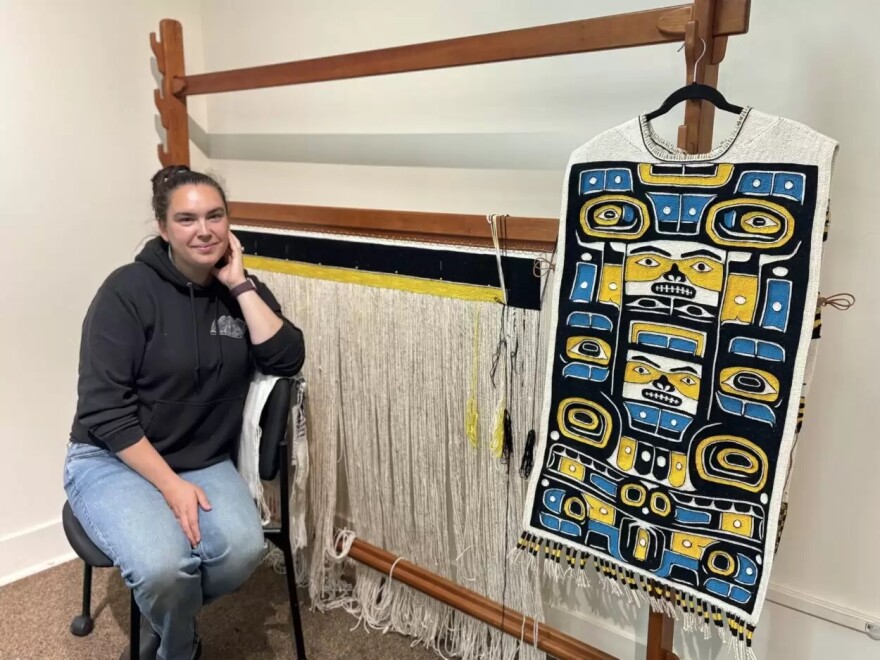Back when she was an art manager at the Sealaska Heritage Institute in 2017, Sydney Akagi would frequently spot people using weaving kits. Inspired by the weaving surrounding her, she scored a spot in Ravenstail and Chilkat weaver Lily Hope’s class, and Akagi was hooked.
“Weaving felt pretty, almost addictive at first. I couldn’t stop,” said Akagi. “I was up late at night. I’d be sitting in bed with tiny projects and wouldn’t go to sleep, and I kind of just lost time.”
Since then, Akagi continued to study under Hope’s tutelage as an apprentice in Juneau, mastering the intricate finger-twining steps of Ravenstail weaving and the geometric designs of the Chilkat style. As her skills improved, Akagi says she was able to find healing and empowerment in her own Lingít identity.
“I think it started to kind of heal some maybe cultural things, a little bit of cultural trauma that I had had from growing up and not feeling accepted and kind of keeping my culture kind of like just at bay and not fully accepting it,” Akagi said. “So it was kind of like my gateway into having that healing with my culture.”
With Hope’s encouragement, Akagi quit her job at the Sealaska Heritage Institute in 2020 to pursue weaving full-time. Now, with nearly a decade of weaving under her belt, she is excited to share her knowledge with Sitkans as the current Native artist resident at the Sheldon Jackson Museum.
There, visitors can view a killer whale Chilkat tunic Akagi completed in 2023. The tunic immediately captures attention as people enter the museum, with its vibrant yellows and blues blasting through its black and white borders to define the whale’s geometric shapes. The tunic’s design mirrors itself on either side in what is known as a distributive design. The tunic is a recreation of one Akagi observed at the Anchorage Museum back in 2022, in order to learn how to weave a traditional tunic.
“There’s not very many weavers that understand the process of creating the shoulders on that tunic, so it felt more almost 3-D versus the flat surface of like a robe that’s hanging on a loom,” said Akagi. “So what I really wanted to do was understand that shoulder, the techniques of creating that and that construction.”
Next to the tunic is one of Akagi’s works-in-progress – a black wall of thread with diamonds swimming across a budding yellow line below it across her weaving loom. These initial threads will eventually culminate into a Chilkat robe depicting a salmon. This robe is unique in that unlike Akagi’s previous pieces like the distributive killer whale tunic, this one will have a configurative design, or an asymmetrical design across the piece.
“So I might be a little anxious before starting that and just having that understanding, but again, that I think that’s part of my evolution as a Chilkat weaver, and like understanding that and gaining all that knowledge,” said Akagi.

The salmon robe was inspired by Akagi’s experience as a resident of the Taku River near Juneau and her advocacy work as a Salmon Beyond Borders Ambassador fighting mining companies whose wastewater endangers the health of the river’s salmon.
“So I was kind of trying to figure out how the art I make, what I could make to kind of bring in a more traditional conversation to these conversations I’ve been having with the CEOs and presidents of these mining companies to ask them to respect our rivers and to do the cleanup,” Akagi said.
Akagi says the work she does, both on her loom and as an advocate for environmental justice, is connected.
“Every part of what I’m creating is from the earth, and so not protecting the Earth only affects what I am creating,” she said.
In addition to a lecture, as part of her residency Akagi will lead a sold-out weaving workshop where participants can create their very own keychains. Akagi is excited to introduce students to the wide-variety of benefits weaving has to offer.
“For kids, weaving can be used as a hands-on method to teach math,” Akagi said. “There’s pattern recognition for anybody older. Just understanding how to do this and use your hands, and even for the cultural reason of being able to connect with the culture or understand the culture. I think there’s so many things that anybody can benefit from learning about weaving.”
Amidst the chaos of balancing numerous other weaving projects with navigating grants and family life, Akagi is grateful to be present in Sitka and engage with the community, exchanging ideas like two threads being woven together to create something meaningful.

